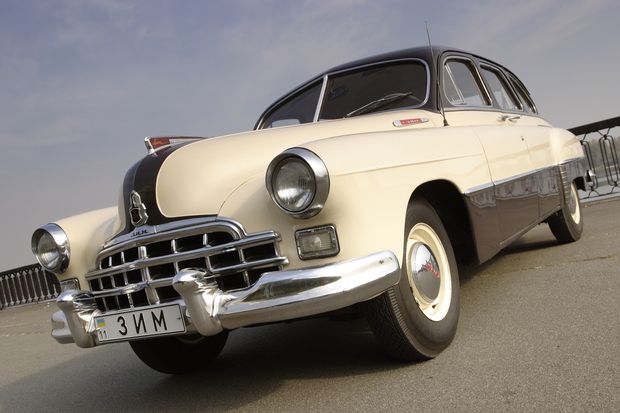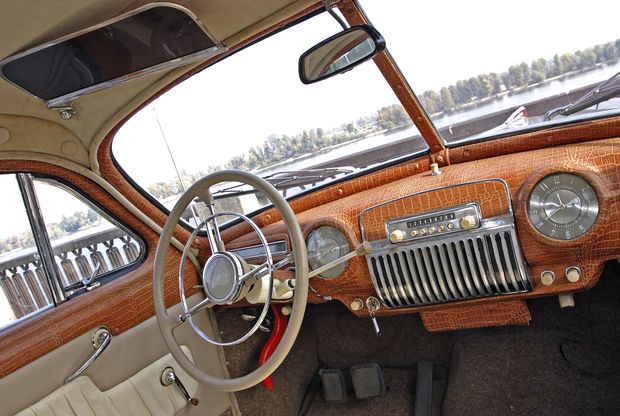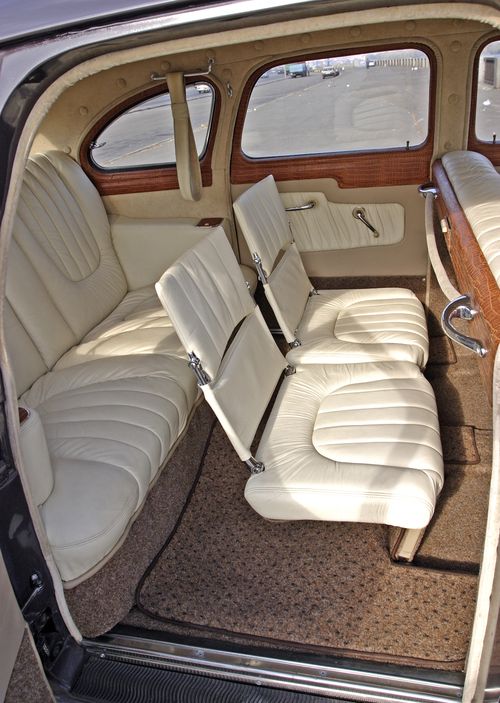Soviet-era “glamour”
Sixty five years ago, in November 1948, the Molotov Automobile Plant in Gorky was assigned to design a full-size executive-class car. We asked Oleksii Sokolov, a well-known Kyiv collector of rare models, including two restored-to-original ZIM cars, to tell us this story
As World War II was over, the USSR needed a new car model to fill the empty niche between quite a luxurious (for that time) ZIS, a very bulky and costly car, and the modest Pobieda (“Victory”) that had recently been put into production. The assignment was fulfilled. In October 1950, the first GAZ-12 car, better known as ZIM (“Molotov Plant”), stepped off the conveyor belt. And although this index was deleted in 1957 after the “anti-Party group of Molotov, Malenkov, et al.” had been condemned, the name ZIM survived the party purge and is still in use.
After the prewar Emka (GAZ-M1), designed in 1935, and the unpretentious Pobieda, ZIM was viewed as symbol of the country’s postwar revival and radiant future. It will be right to say that this mirrored a steep rise of the Soviet automobile-making industry. No other car had such an impact on its further development trends, as ZIM had, and the bold technical improvements still command pride and respect.
This “glamorous,” to use a modern phrase, automobile became an object of desire for top party and state functionaries and a high award for achievements in culture, art, and labor. In spite of a strict nomenklatura hierarchy, officials were so eager to get a personal ZIM that the magazine Krokodil published a satire that called for modesty in the attempts to acquire the right to ride in a new car. ZIMs were on free sale, but its price of 40,000 rubles was only obtainable for the best-known people who had been awarded state prizes or such exalted titles as hero of labor.
There must still be Kyivites who remember the black ZIM that stood in the company of a Pobieda (16,000 rubles) and a Moskvich (9,000 rubles) on the podium of a Tolstoy Square car store.
The output of ZIMs was on the rise, and some of them, in a simplified version, were used as taxis, with the fare being 1.5 times as high as that in a Pobieda. There was also an ambulance modification which replaced the autos based on the GAZ-MM truck. In this case, the stretcher was pushed though the trunk whose lid was fitted with elongated hinges.

THE DESIGN OF THIS SEVEN-SEAT CAR WAS FAMOUS FOR A LARGE NUMBER OF TECHNOLOGICAL INNOVATIONS
This model’s seven-seat design became famous for a large number of technological innovations. And although the outer shape looked like that of the US-made Cadillac, the designers went their own way and created an automobile with three rows of seats in a frameless body. ZIM was first frameless design in the Soviet car-making industry. The car’s transmission system used a hydraulic clutch, which allowed making a smoother start and minimizing the necessity to shift gears. I would say it was a prototype of the automatic gearbox. Although automatic gearboxes had already appeared in the US, it was rather difficult for the postwar Soviet industry to produce them. Synchronizers were also used for the first time in the gearbox to improve the smoothness of movement. It is very important that the engine and many elements of the chassis were standardized with those of the previously produced GAZ-M11-73, Pobieda, and the GAZ-51 truck. This essentially eased the car’s routine maintenance and repairs. This trend also partially extended to Volga, the plant’s next design. I must put special emphasis on the level of comfort in the passenger compartment. For a rather “democratic-purpose” car (for ZIMs were also available as taxis and ambulances, and were on sale), the passenger compartment might be called luxurious – it was very spacious and furnished with chrome-plated, wood-imitation metallic, and ivory-color plastic elements, thick wool textiles and rugs on the floor, a three-band radio, etc. Of special interest were two folding seats, the so-called strapontins, on which children liked to sit in a taxi. Two divans, especially the rear one with armrests, underlined the importance of passengers.

A total of 21,500 ZIM cars were put out in the 10 years of production. The worldwide car making made a leap forward in the 1950s-1960s, and it was decided in 1959, after unsuccessful attempts of modernization, to stop further production of ZIM due to an obsolescent design and the Gorky plant’s conveyor belt gave way to the GAZ-13 Chaika and Volga.
Incidentally, one of the ZIMs I had was displayed in 1958 at Kyiv’s Exhibition of Economic Achievements and gifted by Nikita Khrushchev to his first-marriage daughter who married the Kyiv Opera House director.
ZIM, as a way to show the status of characters, featured in many films (A Driver for Vera, A Wintertime Evening in Gagra, The Secret of the Two Oceans). It also symbolized lifetime achievements in advert posters and was mentioned in literary works.
I recently fully restored a GAZ-MM truck that was produced in 1929 through 1947 and was in fact the first Soviet truck in the period of the country’s industrialization. It was also an indefatigable “worker” on the roads of war. The vehicle’s design is rather simple: it is in fact the Ford TT model which the USSR purchased, together with the equipment for the Gorky plant, in 1929. To restore the truck in its original shape, I brought some elements from the US, where it is very easy to buy them according to the Ford TT catalogue. The vehicle has a mobile power plant with an engine similar to that under the hood. I am busy restoring it now.
Restoring antique automobiles aged over 50 years radically differs from repairing modern ones. While it is not a problem today to get any spare parts for modern-day vehicles and the technology of repairing them boils down to unit replacement rather than to meticulous work, restoring retro cars requires an individual approach and adherence to technological standards and, what is more, certain experience and a non-formalistic, heartfelt, attitude. For only this process allows reproducing the original design and keeping it historical authentic.
There is a more and more acute shortage of specialists capable of these, without exaggeration, deeds, as well as shortage of spare parts. So in my case restoration means not only working with an experienced restorer, but also searching for a “donor,” i.e., one or two vehicles in a more or less repairable condition and, what is more, with as few self-made improvements as possible. I respect masters who can install, for example, a Mercedes engine or an automatic gearbox on a ZIM, but this kind of “restoration” is not interesting for me. It is good that Kharkiv and Zaporizhia enthusiasts are putting automobile restoration on a professional footing.
Newspaper output №:
№77, (2013)Section
Time Out





